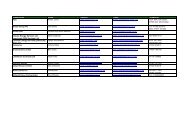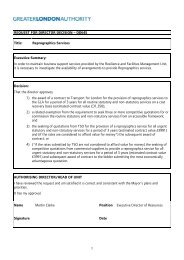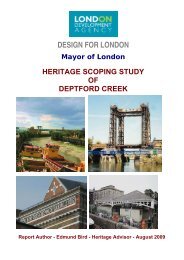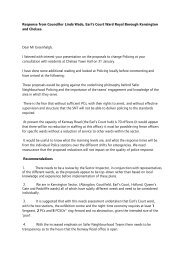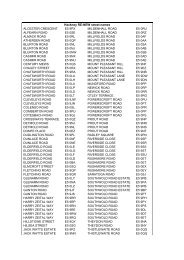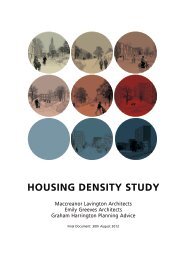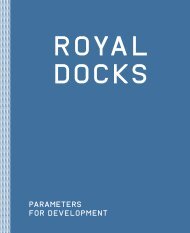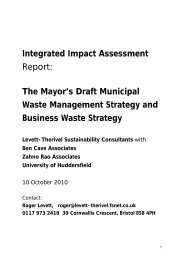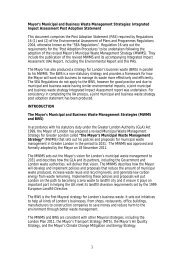AF01 Lee Valley and Finchley Ridge.pdf - Greater London Authority
AF01 Lee Valley and Finchley Ridge.pdf - Greater London Authority
AF01 Lee Valley and Finchley Ridge.pdf - Greater London Authority
You also want an ePaper? Increase the reach of your titles
YUMPU automatically turns print PDFs into web optimized ePapers that Google loves.
Area Strategy – Current Open Space Provision<br />
The Lea <strong>Valley</strong> provides a nearly continuous ribbon<br />
of accessible open space from Hertfordshire to the<br />
Thames - representing a major l<strong>and</strong>scape resource for<br />
<strong>London</strong>. Efforts to create a major open space resource<br />
in the <strong>Valley</strong> date back to the 1960s - since then the<br />
<strong>Lee</strong> <strong>Valley</strong> Regional Park <strong>Authority</strong> has been working<br />
alongside local authorities, government agencies <strong>and</strong><br />
other l<strong>and</strong>owners to realise the aspirations embodied<br />
in the <strong>Lee</strong> <strong>Valley</strong> Regional Park Act. Today, the<br />
boundary of the Lea <strong>Valley</strong> Regional Park (stretching<br />
beyond the edge of <strong>London</strong>) comprises over 4000ha<br />
of l<strong>and</strong>, of which 1600ha are within the ownership of<br />
the <strong>Authority</strong> itself.<br />
Much of this open space lies within the Upper Lea<br />
<strong>Valley</strong>, which provides a largely continuous ribbon<br />
of open space, waterways <strong>and</strong> reservoirs. The<br />
<strong>Authority</strong> provides a range of sports <strong>and</strong> recreation<br />
opportunities in the Upper Lea <strong>Valley</strong>, including<br />
regional centres for athletics, riding <strong>and</strong> ice skating.<br />
The Park also contains large areas of informal open<br />
space <strong>and</strong> highly valued nature reserves, including<br />
a number of Sites of Special Scientific Interest. The<br />
<strong>Authority</strong> is by no means the only open space provider<br />
- with spaces owned by the <strong>London</strong> Boroughs of<br />
Hackney, Waltham Forest, Haringey, Enfield, Epping<br />
Forest District Council, British Waterways, the<br />
Environment Agency <strong>and</strong> Thames Water all making<br />
contributions to the open space network.<br />
The Lower Lea <strong>Valley</strong> represents a very different<br />
l<strong>and</strong>scape to the Upper Lea - with open space provision<br />
far more restricted. A number of smaller open spaces,<br />
local parks <strong>and</strong> nature reserves are scattered down<br />
the <strong>Valley</strong> - with their management diversified across<br />
the Boroughs, the LVRPA, <strong>London</strong> Wildlife Trust <strong>and</strong><br />
other community organisations. The Northern Outfall<br />
Sewer / Greenway - which crosses the <strong>Valley</strong> as it runs<br />
from Abbey Mills to Beckton - forms an important linear<br />
l<strong>and</strong>scape; but the open space network is otherwise<br />
fragmented <strong>and</strong> difficult to navigate. Major projects,<br />
including the Olympic Park <strong>and</strong> the Lea River Park, are<br />
underway to transform the generosity <strong>and</strong> continuity<br />
of open space provision within the Lower Lea.<br />
In the proximity of the Lower Lea, there are some<br />
excellent existing parks - notably Victoria Park <strong>and</strong><br />
Mile End Park - which provide an intriguing contrast<br />
between traditional Victorian park design <strong>and</strong> the<br />
contemporary park spaces being developed within the<br />
<strong>Valley</strong> itself.<br />
The <strong>Finchley</strong> <strong>Ridge</strong> stretching south from the farml<strong>and</strong><br />
of the Green Belt through the suburbs of Enfield,<br />
Barnet <strong>and</strong> Haringey - offers a diverse range of open<br />
spaces. Whilst this territory now divides into the<br />
extensive l<strong>and</strong>scape of the Green Belt (north of Enfield<br />
Town <strong>and</strong> East Barnet), <strong>and</strong> a collection of smaller<br />
open spaces within suburban North <strong>London</strong>, it was<br />
formerly a singular l<strong>and</strong>scape - the ancient woodl<strong>and</strong><br />
of the Forest of Middlesex, which once stretched from<br />
the city walls at Houndsditch. Areas of remaining<br />
woodl<strong>and</strong> across the <strong>Ridge</strong> still offer a memory of its<br />
past - including Monken Hadley Common, Whitewebbs<br />
Park, <strong>and</strong> parts of Trent Park in the north of the area,<br />
<strong>and</strong> Highgate Wood, Queen’s Wood <strong>and</strong> Coppetts Wood<br />
to the south.<br />
In the south of the area, the open space network<br />
comprises a familiar mixture of local parks, recreation<br />
grounds <strong>and</strong> cemeteries. It includes traditional<br />
Victorian parks such as Finsbury Park <strong>and</strong> Alex<strong>and</strong>ra<br />
Park. There are athletics tracks in Finsbury Park <strong>and</strong><br />
Whitehart Lane Community Centre, whilst tennis<br />
courts <strong>and</strong> football pitches are distributed throughout<br />
the area in recreation grounds <strong>and</strong> parks. Numerous<br />
parks across the three boroughs have been awarded<br />
Green Flag status. The presence of the various<br />
tributaries to the River Lea - including Salmons Brook<br />
<strong>and</strong> Pymmes Brook - informs the character of a<br />
number of these spaces. The brooks begin to forge<br />
linear l<strong>and</strong>scape connections between local parks,<br />
although these are often fragmentary <strong>and</strong> incomplete.<br />
The l<strong>and</strong>scape begins to transform towards the Green<br />
Belt. A number of golf courses are found in the north<br />
of Enfield - marking the transition between suburban<br />
city <strong>and</strong> surrounding countryside. The Green Belt<br />
itself comprises a mixture of arable farml<strong>and</strong> <strong>and</strong><br />
woodl<strong>and</strong>, within which the 170 hectare Trent Country<br />
Park, (l<strong>and</strong>scapes by Humphry Repton) <strong>and</strong> Forty<br />
Hall Country Park museum within its Grade 1 listed<br />
Jacobean house, provide significant public l<strong>and</strong>scapes<br />
<strong>and</strong> visitor destinations. The Green Belt also serves<br />
to connect the <strong>Finchley</strong> <strong>Ridge</strong> to the Lea <strong>Valley</strong>, via<br />
the course of the <strong>London</strong> Loop. which follows Turkey<br />
Brook.<br />
Between the <strong>Ridge</strong> <strong>and</strong> the Lea <strong>Valley</strong> itself, the New<br />
River - an artificial waterway built in the 17th Century<br />
to supply fresh drinking water from the River Lea to<br />
<strong>London</strong> - also provides an important north-south<br />
walking route.<br />
Scheduled Future Change<br />
Substantial change to the open space provision within<br />
the area is already underway. Much of this change is<br />
focussed on the Lower Lea <strong>Valley</strong> - where a number<br />
of projects are being progressed to develop a more<br />
continuous open space network which will finally<br />
make possible a generous connection between the<br />
Regional Park <strong>and</strong> the Thames.<br />
The centre-piece of this transformation is the<br />
regeneration opportunity presented by the 2012<br />
Olympics; the creation of the Olympic Park at the<br />
junction with the Upper Lea <strong>Valley</strong> has served to<br />
catalyse wider change as well as itself delivering a<br />
major new park for <strong>London</strong>. The new park will be the<br />
focal point of mixed-use development across 200 ha<br />
of former industrial l<strong>and</strong> <strong>and</strong> l<strong>and</strong>fill sites. Significant<br />
improvements to the open spaces at the immediate<br />
periphery of the Park - such as the transformation of<br />
the Greenway <strong>and</strong> works to Hackney Marshes - have<br />
already been delivered under the impetus of the<br />
Olympic project.<br />
To the south of the Olympic Park, the Lea River<br />
Park promises to deliver the final connection to the<br />
Thames. Over the long-term, the Lea River Park will<br />
itself deliver major areas of new park space in the<br />
south of the Lower Lea. In the short term, the delivery<br />
of a continuous north-south route - the Fatwalk - is<br />
being prioritised <strong>and</strong> will transform the accessibility<br />
<strong>and</strong> visibility of this part of the Lea <strong>Valley</strong>.<br />
Future change in the Upper Lea <strong>Valley</strong> - will be less<br />
spectacular <strong>and</strong> more incremental, but no less<br />
important. A major new l<strong>and</strong>scape strategy has<br />
been developed by key public sector organisations,<br />
setting out a long-term vision for this part of the area,<br />
<strong>and</strong> major initiatives include the opening up to public<br />
access of the Walthamstow Reservoirs.<br />
Aspirations for a network of new <strong>and</strong> better connected<br />
open spaces are recognised as essential components<br />
in creating successful new communities across the<br />
area. Further details are provided on recent progress<br />
to deliver this, <strong>and</strong> anticipated future projects, in the<br />
later parts of this document.<br />
11



